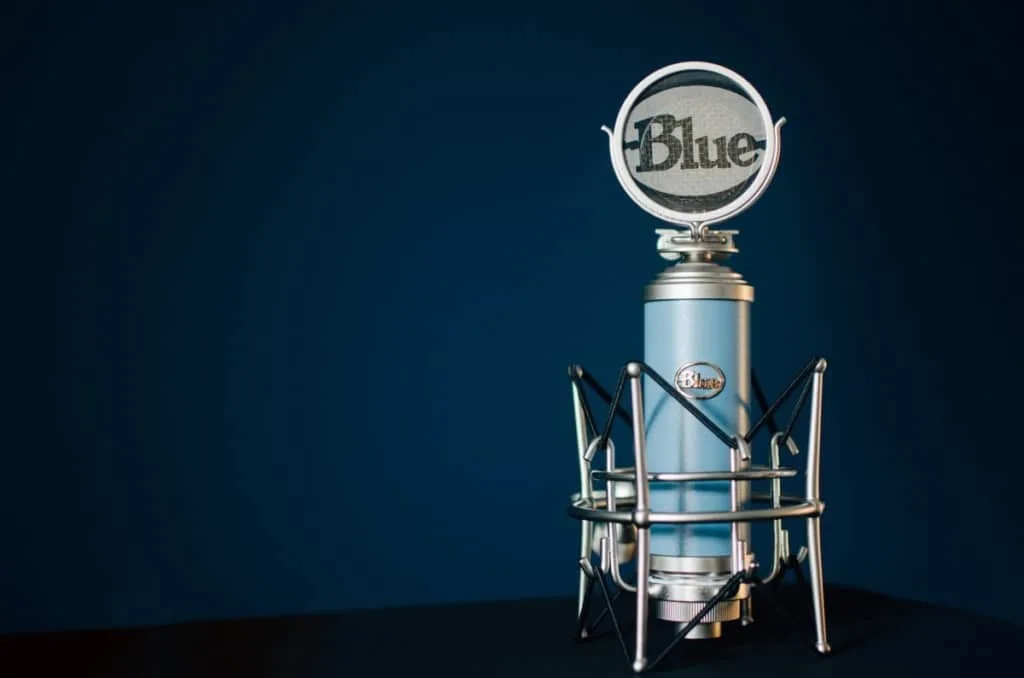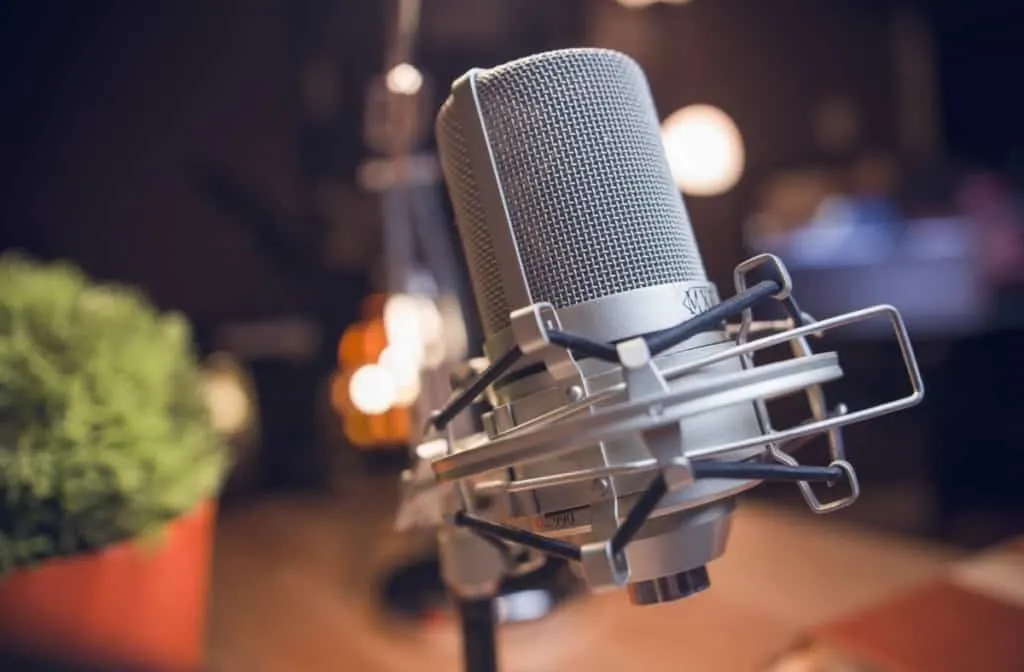Shock mounts are devices that absorb low-end frequencies so that they don’t make it into a recording. They are often used with condenser microphones to improve the overall clarity of the sound captured.
Do you need a shock-mount for your Blue Yeti?
Although a Blue Yeti will function without a shock mount, using one will improve its performance. The device provides you with more freedom when using a Blue Yeti microphone, and prevents any unwanted noise from making it into your recordings.
Shock mounts offer numerous benefits when recording with any microphone, but are especially useful when used with a desktop USB mic like the Blue Yeti.
The last thing you want when recording podcasts, audio for video, or gaming purposes is low-end rumble being present in the output. In this article, I’ll explain why you need a shock mount to get the best out of your Blue Yeti.

Why You Should Use A Shock Mount With A Blue Yeti
The Blue Yeti is without a doubt one of the most popular microphones in production today. Compact and versatile, it is popularly used for several purposes including podcasting, voiceovers, and live-streaming.
One of the only drawbacks of the Blue Yeti is the stand that accompanies it.
Although it can hold the microphone firmly in place, it doesn’t do anything to minimize noise issues that can be a result of sound traveling through a desk or surface into the mic, or from unintentionally coming into contact with the stand.
That’s where a shock mount comes in handy.
These smartly-designed devices are perfectly suited to use with a Blue Yeti. A shock mount is essentially a tool that forms an attachment between the Blue Yeti and its stand. It is absorbent and shields the microphones from vibrations and noise that come through the surface or mic stand.
One could argue that using a shock mount with your Blue Yeti is not essential.
Granted, the microphone will still be able to record just fine without one. However, there are likely to be constant noises, such as rustling or knocking, present in the microphone’s output.
To combat these issues, a shock mount holds the Blue Yeti in a gentle enclosure which is often made up of rubber bands. This prevents the noise from traveling through the stand and reaching the microphone, thus improving the overall clarity of recording live-streams.
Shockmounts, like all pieces of audio equipment, come in many variations with differing capabilities.
There is an official Blue Yeti shock mount made by the microphone manufacturers which does a great job. It is a little on the expensive side though, and there are plenty of other options that you can choose from.
Check out this Blue Yeti shock mount on Amazon.
Indeed, using a shock mount with your Blue Yeti is pretty much guaranteed to improve its performance. There are, however, other components that can allow the shock mount to function to the best of its ability.
I have written a separate article on shock mounts. You can find it here.
In the table below, you can see the specifications of the Blue Yeti in comparison to other popular mics, to gain an understanding of the benefits a shock mount can offer it:
| Microphone | Frequency Range | Max SPL | Type |
| Blue Yeti | 20Hz-20kHz | 120dB | Condenser |
| Shure SM57 | 40Hz-15kHz | 190dB | Dynamic |
| Rode N1-A | 20Hz-20kHz | 137dB | Condenser |
The Various Benefits Of A Shock Mount With A Blue Yeti
One of the main benefits of using a shock mount with a Blue Yeti microphone is the reduction of rumble.
The standard swivel stand mount does little to combat this issue, whereas a shock mount is specifically designed to absorb the low-end problematic frequencies.
This not only improves the clarity of your Blue Yeti recordings but also makes the low-end sound more powerful.
The lack of unwanted rumble draws more attention to the genuine bass frequencies of the sound source. For example, if the Blue Yeti is used to record speech, the low-end of a person’s voice will be more distinguishable due to the lack of unwanted frequencies.
When searching for a shock mount to pair with a Blue Yeti, there are a few main qualities to look out for. Firstly, you want to ensure maximum shock absorption. This quality is determined by the elasticity of the suspension.
Most shock mounts use rubber ribbons, as this material is sturdy enough to hold the Blue Yeti firmly in place, without restricting its natural movement too much. To ensure that the shock mount performs well with the Blue Yeti, it’s imperative to choose one that is the correct size to facilitate it.
If the shock mount is too tight, this will adversely affect its ability to absorb the necessary frequencies, and therefore it won’t be of much use.
Blue Yeti microphones are of a standard-sized as far as condensers are concerned, so choosing a shock mount that is built for this type of microphone is a good idea.
When recording, there’s nothing worse than capturing what you thought was the perfect take, only to find that unwanted noises have marred it when you listen back. Despite the commendable robustness and ability of a Blue Yeti, it is not immune from such issues.
Another benefit of pairing these two devices is the positional freedom provided. Standard microphone stands or boom-arm desktop stands can be difficult to maneuver and position. When recording vocals, it’s important that your posture is correct and that you are as comfortable as possible.
If you’re stretching to reach the microphone, or slightly hunched over due to the positional limitations of the stand, this will affect the way your voice sounds and will be reflected in any recordings you make with your Blue Yeti.
- The great thing about shock mounts is that they are easy to move into the perfect position for your recordings.
Because they are suspended away from the stand, they extend the overall length. The angle of the shock mount can also be adjusted so that the Blue Yeti’s capsule is directly facing the sound source.
It’s important to bear in mind that shock mounts are not universal devices, so not all of them will be compatible with a Blue Yeti. Checking that the dimensions of the microphone line up with those of the shock mount are a good way to ensure that the two devices are capable of working together.
Check out this useful video that offers tips on getting the most out of your Blue Yeti microphone.
Other Tools To Pair With A Blue Yeti
If you use your Blue Yeti microphone with a shock mount and no additional equipment, you’ll get a good standard of recording. This basic setup can be enhanced by using other devices to complement the combination of the shock mount and the Blue Yeti.
Perhaps the most important addition you can make other than a shock mount is a pop filter.
Pop filters are highly compatible with shock mounts, and they perform the vital function of minimizing the appearance of plosives in your recordings.
When a vocalist sings or speaks into the Blue Yeti microphone, certain letters and phrases create unpleasant sounds. These sounds are known as plosives, and they cause the microphone to capture pops, hisses, and other undesirable tones. Using a pop filter with your shock mount is the best way to combat this issue.
Check out my article on pop filter types here.
Due to the sensitive nature of the Blue Yeti condenser microphone, it picks up all of the fine details of the sound source it is recording. Therefore, it is especially susceptible to plosives, just like it is susceptible to the low-end rumble that shock mounts are designed to combat.
Pop filters work by either deflecting or softening the air pressure after it leaves a vocalist’s mouth. There are multiple types of pop filters, but the two most common are nylon and metal designs.
Nylon pop filters soften the air before it reaches the Blue Yeti, and diffuse it so that the plosives are less prominent. Metal pop filters, on the other hand, actually deflect and redirect the air so that it doesn’t get close to the capsule of the Blue Yeti.
Similar to shock mounts, pop filters also offer positional benefits that can improve the recordings you make with your Blue Yeti. The shield is positioned in front of the microphone and therefore prevents the vocalist from getting too close to the Blue Yeti’s capsule.
This prevents clipping from occurring, which is the process when the sound source reaches a volume that is too high for the microphone to handle. The result is digital distortion, which in most cases isn’t desirable.
Other components such as the XLR cables you use and the audio interface that is used to record the Blue Yeti will also impact the way that it performs. Overall, adding a shock mount is a great starting point, and will benefit your recordings tremendously.

Related Questions
Do condenser mics need phantom power?
Yes, all condenser microphones require phantom power, but there is one exception to this rule. USB condenser microphones are powered by the computer, and therefore don’t require additional phantom power.
Check out my article that compares USB and XLR Microphones here.
Which cables can you use with a Blue Yeti?
The Blue Yeti microphone uses USB connectivity. You simply plug a USB cable into the microphone at one end, and into your computer at the other end.
What polar patterns does a Blue Yeti use?
The Blue Yeti microphone offers multiple polar patterns. These include cardioid, bidirectional, omnidirectional, and stereo. This versatility is one of the reasons the microphone is so popular.
